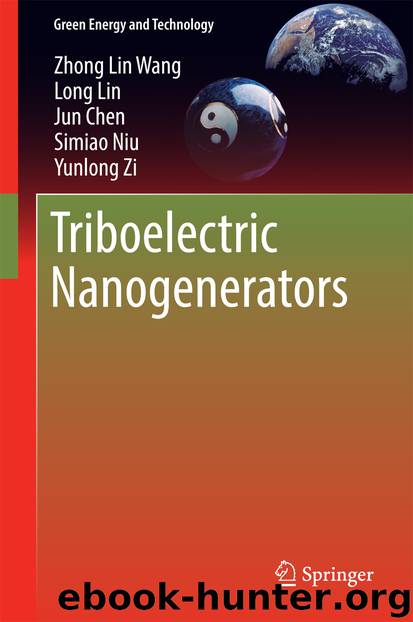Triboelectric Nanogenerators by Zhong Lin Wang Long Lin Jun Chen Simiao Niu & Yunlong Zi

Author:Zhong Lin Wang, Long Lin, Jun Chen, Simiao Niu & Yunlong Zi
Language: eng
Format: epub
Publisher: Springer International Publishing, Cham
In summary, a SFT mode wind-driven TENG with ability of automatic transition between contact state and non-contact state has been demonstrated. The TENG has shown promising output performance with extraordinary long-term stability due to automatic transition. This TENG has been demonstrated to be an ideal energy harvester for wind energy.
10.1.2 Other Rotational Structures for Wind Energy Harvesting
Xie et al. developed a rotary structured triboelectric nanogenerator (R-TENG) for scavenging weak wind energy [4]. Under the wind flow, the wind-cup structure will be driven to rotate and thus the soft and flexible polytetrafluoroethylene (PTFE) film based rotor blade will sweep across the Al sheets based stators consecutively, so that a repeating process of contact-sliding-separation-contact between the two charged surfaces can be achieved by hybridizing the two modes. On the basis of this new design, an open-circuit voltage (V OC) of 250 V and short-circuit current (I SC) of 0.25 mA have been reached, corresponding to a maximum power output of 62.5 mW, which is capable of either driving hundreds of electronic devices (such as commercial LEDs) instantaneously or efficiently charging energy storage units. This work is the first one to use TENG technology to effectively harvest wind energy , which is an important progress in the practical applications of nanogenerators and also exhibits enormous potential as the future wind power technology.
The structure of the R-TENG springs from the conventional wind cup structure , which includes a framework, a shaft, a flexible rotor blade, two stators, as illustrated in Fig. 10.3a. The framework for supporting the entire structure consists of two Acrylic rectangles that are joined together perpendicularly at the common central axes, where the metallic shaft rod is positioned through two bearings. A flexible and soft rotor blade structurally made of a polyester (PET) film (∼125 μm in thickness) is connected to the shaft, and thus can rotate with the shaft. Around the circumference of the device, two Al covered plates as the symmetric stators stretch out from the framework toward the shaft direction. On top of the shaft, the wind cup setup is mounted to convert the wind flow into the rotation of the shaft and the flexible rotor, during which the rotor blade will periodically sweep across the stators with small resistance. In this process, a consecutive face-to-face contact (in area of 2.5 cm × 6.4 cm) and separation between the rotor and the stators will be enabled, which can serve as the basic TENG-based process for generating electricity. According to the triboelectric series, a PTFE film was chosen to adhere at the end of the PET blade as a triboelectric layer to get into contact with Al that acts not only as the counter triboelectric layer, but also as an electrode. For the other electrode, a layer of metal film was deposited between the PTFE and PET to enable the transfer of induced charges. To enhance the surface roughness and therefore improve the triboelectric charge density, the PTFE film was dry-etched through inductive coupled plasma (ICP) reactive ion etching to prepare nanowire-like structures on the surface (with the magnified scheme in Fig.
Download
This site does not store any files on its server. We only index and link to content provided by other sites. Please contact the content providers to delete copyright contents if any and email us, we'll remove relevant links or contents immediately.
| Automotive | Engineering |
| Transportation |
Whiskies Galore by Ian Buxton(41939)
Introduction to Aircraft Design (Cambridge Aerospace Series) by John P. Fielding(33093)
Small Unmanned Fixed-wing Aircraft Design by Andrew J. Keane Andras Sobester James P. Scanlan & András Sóbester & James P. Scanlan(32764)
Craft Beer for the Homebrewer by Michael Agnew(18197)
Turbulence by E. J. Noyes(7978)
The Complete Stick Figure Physics Tutorials by Allen Sarah(7338)
Kaplan MCAT General Chemistry Review by Kaplan(6900)
The Thirst by Nesbo Jo(6881)
Bad Blood by John Carreyrou(6583)
Modelling of Convective Heat and Mass Transfer in Rotating Flows by Igor V. Shevchuk(6406)
Learning SQL by Alan Beaulieu(6237)
Weapons of Math Destruction by Cathy O'Neil(6215)
Man-made Catastrophes and Risk Information Concealment by Dmitry Chernov & Didier Sornette(5956)
Digital Minimalism by Cal Newport;(5704)
Life 3.0: Being Human in the Age of Artificial Intelligence by Tegmark Max(5516)
iGen by Jean M. Twenge(5385)
Secrets of Antigravity Propulsion: Tesla, UFOs, and Classified Aerospace Technology by Ph.D. Paul A. Laviolette(5333)
Design of Trajectory Optimization Approach for Space Maneuver Vehicle Skip Entry Problems by Runqi Chai & Al Savvaris & Antonios Tsourdos & Senchun Chai(5037)
Pale Blue Dot by Carl Sagan(4954)
